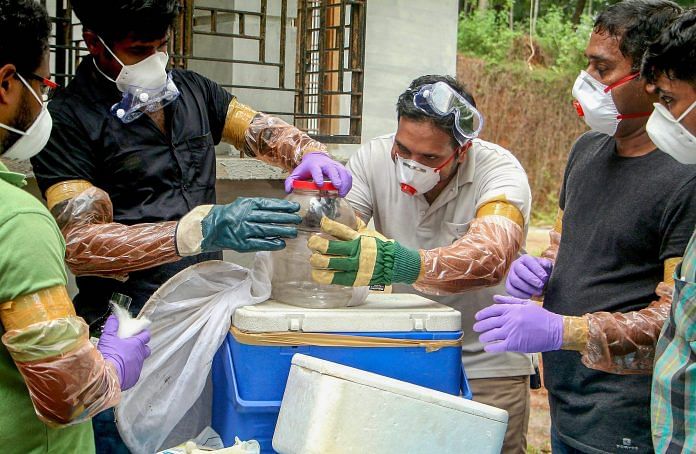New Delhi: Kerala has now confirmed a third case of coronavirus after a patient tested positive for the infection in Kasargod. The patient had recently returned to Kasargod from China.
The first two cases were also of patients with a recent China travel history. They were reported from Thrissur and Alappuzha districts.
The new deadly coronavirus has so far claimed over 360 lives in China.
After the second confirmed case of the virus in Kerala Sunday, the state’s Health Minister K.K. Shailaja said Kerala would deal with the situation the way it dealt with the Nipah outbreak in 2018.
“Nipah was most dangerous and still we contained it effectively. The state will overcome the present situation,” she said, adding the government is on high alert and wouldn’t lower its guard.
In 2018, Nipah, a zoonotic virus that spreads from animals to humans, killed 17 people in Kerala.
The state government’s initiatives and swift action successfully contained the outbreak. In 2019, another case of Nipah virus was reported but it didn’t spread.
What is Nipah virus?
The first Nipah virus outbreak was reported among pigs in Sungai Nipah village in Malaysia in 1998-99. However, the virus spread from pigs to humans and over 300 people were infected.
The virus spreads if one is in close contact with Nipah-infected people, bats or pigs.
According to the guidelines issued by the National Centre for Disease Control, “Bat secretions laden with virus can infect people during fruit tree climbing, eating/handling contaminated fallen fruits or consuming raw date palm sap/juice or toddy.”
Some of the symptoms of Nipah virus include brain fever, fever with cough, difficulty in breathing and respiratory infection.
Also read: If Ebola, Zika and Nipah can cross borders, so can technology. That’s where solution lies
Kerala govt’s initiatives to tackle Nipah
Once the outbreak was reported, doctors in public and private hospitals issued alerts for people diagnosed with pneumonia-like symptoms. After officials announced that the virus was being spread through fruits eaten by bats, people significantly cut down fruit consumption.
After the first person was diagnosed with the virus, an officer trained in Ebola outbreak protocols advised the doctors in the state on infection control measures. These measures included “isolating patients, using surgical masks and decontaminating surfaces”.
Speaking to ThePrint, Dr A.V. Jayakrishnan, member of the Indian Medical Association, recalled, “During the outbreak, the main breakthrough was when the patient was admitted to hospital. In that hospital, the doctor evaluating the symptoms went through literature and found out that it was a strain of Nipah virus.”
“Subsequently, when it was diagnosed, the government immediately swung into action, which is why the situation was controlled,” he added.
Rajeev Sadanandan, an IAS officer who worked closely with Health Minister Shailaja at the time of the outbreak, told ThePrint, “I think contact tracing was the most effective initiative taken by the government to control the outbreak. Once the cases were identified, we traced every possible person who had been infected.”
“Every trace we picked up figured in our list of potential people who could be affected,” he added.
The government’s swift action at contact tracing proved to be successful in containing the Nipah virus because unlike other viruses, Nipah doesn’t spread as efficiently. It only moves to people within a metre of infected patients.
When asked whether the methods of tackling coronavirus and Nipah virus are comparable, Sadanandan replied, “Not really. The advantage of coronavirus is that the focal point of the epidemic is known, so one has to follow up with all the people with travel history to Wuhan.”
Dr Jayakrishnan said isolation is one of the most effective methods to control the spread of infection.
“One of the takeaways from the Nipah virus outbreak was that isolation is one of the most effective methods to control spread of infection.”
He added, “Symptomatic patients should be treated and isolated.”
What the Kerala govt lacked
At the time of the outbreak, Kerala lacked testing facilities.
Samples of Nipah-suspected patients had to be flown to NIV (non-invasive ventilation) testing centres in Pune, which would take over 24 to 36 hours to deliver the results.
The recurrence of Nipah virus cases in 2019 suggested that the state’s health department may have been able to contain the epidemic once it appeared. But, it hasn’t been able to trace the virus and contain it at its very source.
According to a report, one of the “weirdest anomalies of Kerala’s famed health record” is that it doesn’t have a separate Directorate for Public Health. The state also lacks a ‘cadre’ of trained public health professionals to track infectious viral diseases.
Also read: As Nipah virus strikes again, here are the symptoms, how it spreads and its fatality rate






